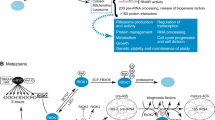Abstract
Ribosomal S6 kinase 2 (S6K2) is one of the kinases regulated by the mammalian target of rapamycin (mTOR) signaling pathway. Although it has been identified as a kinase homologous to S6K1, evidence suggests that the two kinases have non-overlapping functions, and the biological function of S6K2 still remains unknown. In order to identify the cell cycle stage(s) during which S6K2 plays a role, we assessed changes in the catalytic activity of S6K2 throughout the cell cycle. Our data show that S6K2 is active throughout the cell cycle with higher activity in G2 and M phases. We also show that S6K1 activity peaks sharply during M phase. Our data suggest that S6K1 and S6K2 likely play yet-unknown roles in G2 and M phases.



Similar content being viewed by others
Abbreviations
- S6K1:
-
Ribosomal S6 kinase 1
- S6K2:
-
Ribosomal S6 kinase 2
References
Shima H, Pende M, Chen Y, Fumagalli S, Thomas G, Kozma SC (1998) Disruption of the p70(s6k)/p85(s6k) gene reveals a small mouse phenotype and a new functional S6 kinase. Embo J 17:6649–6659
Lee-Fruman KK, Kuo CJ, Lippincott J, Terada N, Blenis J (1999) Characterization of S6K2, a novel kinase homologous to S6K1. Oncogene 18:5108–5114
Gout I, Minami T, Hara K, Tsujishita Y, Filonenko V, Waterfield MD, Yonezawa K (1998) Molecular cloning and characterization of a novel p70 S6 kinase, p70 S6 kinase beta containing a proline-rich region. J Biol Chem 273:30061–30064
Koh H, Jee K, Lee B, Kim J, Kim D, Yun YH, Kim JW, Choi HS, Chung J (1999) Cloning and characterization of a nuclear S6 kinase, S6 kinase-related kinase (SRK); a novel nuclear target of Akt. Oncogene 18:5115–5119
Saitoh M, ten Dijke P, Miyazono K, Ichijo H (1998) Cloning and characterization of p70(S6K beta) defines a novel family of p70 S6 kinases. Biochem Biophys Res Commun 253:470–476
Fingar DC, Blenis J (2004) Target of rapamycin (TOR): an integrator of nutrient and growth factor signals and coordinator of cell growth and cell cycle progression. Oncogene 23:3151–3171
Richardson CJ, Schalm SS, Blenis J (2004) PI3-kinase and TOR: PIKTORing cell growth. Semin Cell Dev Biol 15:147–159
Mamane Y, Petroulakis E, LeBacquer O, Sonenberg N (2006) mTOR, translation initiation and cancer. Oncogene 25:6416–6422
Ohanna M, Sobering AK, Lapointe T, Lorenzo L, Praud C, Petroulakis E, Sonenberg N, Kelly PA, Sotiropoulos A, Pende M (2005) Atrophy of S6K1(-/-) skeletal muscle cells reveals distinct mTOR effectors for cell cycle and size control. Nat Cell Biol 7:286–294
Pende M, Um SH, Mieulet V, Sticker M, Goss VL, Mestan J, Mueller M, Fumagalli S, Kozma SC, Thomas G (2004) S6K1(-/-)/S6K2(-/-) mice exhibit perinatal lethality and rapamycin-sensitive 5′-terminal oligopyrimidine mRNA translation and reveal a mitogen-activated protein kinase-dependent S6 kinase pathway. Mol Cell Biol 24:3112–3124
Phin S, Kupferwasser D, Lam J, Lee-Fruman KK (2003) Mutational analysis of ribosomal S6 kinase 2 shows differential regulation of its kinase activity from that of ribosomal S6 kinase 1. Biochem J 373:583–591
Rossi R, Villa A, Negri C, Scovassi I, Ciarrocchi G, Biamonti G, Montecucco A (1999) The replication factory targeting sequence/PCNA-binding site is required in G(1) to control the phosphorylation status of DNA ligase I. Embo J 18:5745–5754
Rossi R, Pester JM, McDowell M, Soza S, Montecucco A, Lee-Fruman KK (2007) Identification of S6K2 as a centrosome-located kinase. FEBS Lett 581:4058–4064
Edelmann HM, Kuhne C, Petritsch C, Ballou LM (1996) Cell cycle regulation of p70 S6 kinase and p42/p44 mitogen-activated protein kinases in Swiss mouse 3T3 fibroblasts. J Biol Chem 271:963–971
Volarevic S, Thomas G (2001) Role of S6 phosphorylation and S6 kinase in cell growth. Prog Nucleic Acid Res Mol Biol 65:101–127
Avruch J, Belham C, Weng Q, Hara K, Yonezawa K (2001) The p70 S6 kinase integrates nutrient and growth signals to control translational capacity. Prog Mol Subcell Biol 26:115–154
Acknowledgments
This work was supported by MBRS SCORE grant from National Institute of Health (grant no. 1 S06 GM63119-01 and 2 S06 GM063119-05) and HHMI (grant no. 52002663).
Author information
Authors and Affiliations
Corresponding author
Rights and permissions
About this article
Cite this article
Boyer, D., Quintanilla, R. & Lee-Fruman, K.K. Regulation of catalytic activity of S6 kinase 2 during cell cycle. Mol Cell Biochem 307, 59–64 (2008). https://doi.org/10.1007/s11010-007-9584-5
Received:
Accepted:
Published:
Issue Date:
DOI: https://doi.org/10.1007/s11010-007-9584-5




